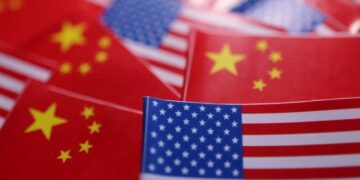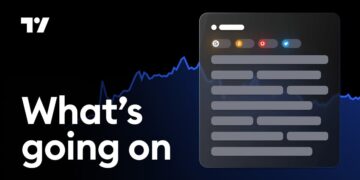Wall Street gave back some of the historic gains made a day earlier when President Donald Trump paused his latest tariff hikes on U.S. trading partners, with the exception of China.
In morning trade on Thursday, the S&P 500 was down 126 points, or 2.3%, to 5,331, while the Dow Jones Industrial Average dropped 869 points, or 2.1%. The tech-heavy Nasdaq fell 3%.
It’s been a wild couple of weeks on Wall Street with Mr. Trump’s tariff announcements, reversals and retaliation from U.S. trading partners. That volatility seems unlikely to change in the coming weeks with the U.S. and China still locked in a tit-for-tat tariff battle and earnings season kicking off on Friday with the latest results from some of the nation’s biggest banks.
“Despite Wednesday’s announcements to lower the reciprocal tariff rate for most countries to 10%, the escalation between the U.S. and China could dramatically impact trade between the world’s two largest economies,” said Mark Haefele, global chief investment officer for wealth management at UBS, in a research note.
Taking into account Mr. Trumps 125% levy on Chinese imports, UBS currently estimates the overall U.S. effective tariff rate at 27%, versus 9% prior to April 2. “Excluding trade with China, the effective tariff rate is 11%,” Haefele added.
Future is still unclear as trade war continues
“Everything is still very volatile, because with Donald Trump, you don’t know what to expect,” said Francis Lun, chief executive of Geo Securities. “This is really big uncertainty in the market. The threat of recession has not faded.”
Markets had been sinking earlier Wednesday on worries that Mr. Trump’s trade war could drag the global economy into a recession. But then came the posting on social media that investors worldwide had been waiting and wishing for.
“I have authorized a 90 day PAUSE,” Mr. Trump said, saying more than 75 countries are negotiating on trade and not retaliating against his latest increases in tariffs. China was a huge exception, with the president saying tariffs are going up to 125% against its products.
Investors went “from fear to euphoria,” Stephen Innes, managing partner at SPI Asset Management, said in a commentary. On Wednesday, following Mr. Trump’s tariff-pause announcement, the S&P 500 surged 9.5%, its third-best day since 1940. The index is still below where it was when Trump announced his sweeping set of tariffs last week. The Dow Jones Industrial Average shot to a gain of nearly 3,000 points, or 7.9%. The Nasdaq composite leaped 12.2%.
“It’s now a manageable risk, especially as global recession tail bets get unwound, and most of Asia’s exporters breathe a massive sigh of relief,” Innes said. Analysts had expected the global comeback given that U.S. stocks had one of their best days in history on Wednesday as investors registered their relief over Trump’s decision.
The trade war isn’t over, and an escalating battle between the world’s two largest economies can create plenty of damage. U.S. stocks are also still below where they were just a week ago. Technology stocks were the biggest drag on markets in early trading Thursday, followed by the industrial and the financial sectors.
CPI report brings good news
On a positive note, the U.S. government’s latest consumer inflation data revealed inflation in March rose 2.4% on an annual basis, a sign of progress in the Federal Reserve’s battle to bring down inflation to a 2% rate.
“This month’s inflation report showed that CPI dropped across the board in March, which is welcome news for the Federal Reserve, which would like to cut rates if significant damage is done to the economy through increased tariffs, but otherwise would be reluctant to cut rates in the face of an inflation threat,” said Chris Zaccarelli, chief investment officer for Northlight Asset Management.
March “saw a fairly big cooling in inflation (both headline and core) and this, coupled w/the healthy job adds from last week, point to robust underlying economic fundamentals. The downtick in inflation gives breathing room for the Fed to be more forceful in responding to market turmoil,” said equity analyst Adam Crisafulli, head of Vital Knowledge, in a report.
From bear investors’ perspective, however, “inflation is still running above the Fed’s target and regardless, Mar and Q1 numbers are irrelevant given how much the world has changed. Trump’s tariffs are only hitting the economy now, and it will take months before they fully show up in the data,” Crisafulli added.
In other words, according to most analysts, the situation is still too uncertain to call.
“It’s much too soon to blow the all clear — both on tariffs or on inflation — since the tariff damage has only been postponed as of now, and will only be relieved if tariff deals can be struck across the board,” Zaccarelli said.
“Inflation still remains a concern because the full impact of tariffs is yet to be felt, however, at least the underlying trends (e.g. non-tariff related inflation) seems benign at this time. We will be keeping a close eye on PPI tomorrow in order to determine whether or not future inflation is already in the pipeline,” he added.


















